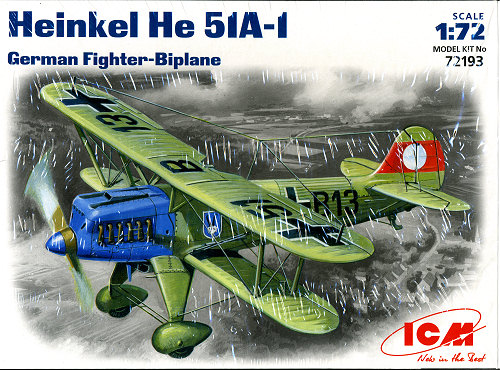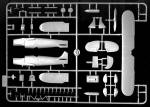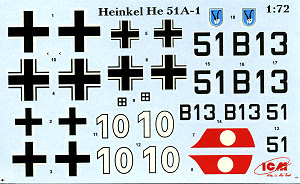
| KIT: | ICM 1/72 He-51A-1 |
| KIT #: | 72193 |
| PRICE: | $11.98 MSRP |
| DECALS: | Two options |
| REVIEWER: | Scott Van Aken |
| NOTES: | New mold? |

| HISTORY |
The He 51 was a conventional biplane fighter, which first flew in May 1933 when the Luftwaffe was still a secret. Deliveries started in July of the next year, the 51 was intended to replace the earlier Arado Ar 65 and 68s but they ended up flying side by side. The He 51 was outdated the day it entered service, and after an initial run of 75 production fighters, the design was switched into the B-2 reconnaissance floatplane for another 80, and then finally the C-1 light ground attack plane for a further 79.
On August 6th, 1936 six of the planes were sent to Spain to fight in the Spanish Civil War. Deliveries continued until there were three squadrons of 12 planes each, and the Legion Kondor (Condor Legion) was formed from these squadrons in November. Deliveries continued as the hostilities increased, and the plane met and beat a number of older biplane designs.
This time of superiority was short lived. The arrival of the superior Polikarpov I-15 started its downfall, and when the new Polikarpov I-16 monoplane arrived it was clearly hopeless. The He 51 was withdrawn from fighter duty and relegated to the ground attack role, and then eventually to training. After the war the 46 surviving planes would be joined by another 15 new builds, and serve in the utility role in Spain until 1952.
The experiences in Spain would prove once and for all that the days of the biplane fighter were over. Although the later model Fiat biplanes were superior to the He 51 and continued to soldier on in Nationalist service, the I-16 monoplanes were basically untouchable because of their speed. If the conditions were right they could use their heavy armament in a quick pass and then leave, if things weren't so favorable they simply flew away. The lesson learned by all of the participants was that speed was far more important in combat than maneuverability.
None were still in frontline service with the Luftwaffe at the start of World War 2. It was used as a trainer and utility aircraft during the war.
| THE KIT |
 The end opening box contains a resealable bag (a great way to do things and I approve) containing one sprue of plastic and an acetate windscreen (which is stuck to the seal to keep it from disappearing). The light grey plastic is really well done with believable fabric representations on the fuselage and wings. There is also framework detail on the inside of the cockpit, but as with many of the fighters from this era, little will be seen. The cockpit itself is basic with a floor, seat, stick and instrument panel.
The end opening box contains a resealable bag (a great way to do things and I approve) containing one sprue of plastic and an acetate windscreen (which is stuck to the seal to keep it from disappearing). The light grey plastic is really well done with believable fabric representations on the fuselage and wings. There is also framework detail on the inside of the cockpit, but as with many of the fighters from this era, little will be seen. The cockpit itself is basic with a floor, seat, stick and instrument panel.
The exhaust system is made up of individual stacks with a two part manifold. While fiddly looking, it also looks like it will not be a difficult assembly. The wings are one piece with holes for the struts. The areas where the rigging is attached are shown by circles so those that want to pre-drill rigging attachment holes will find that helpful. Landing gear looks to be a bit complex with the  builder having to cut 2mm from the gear legs (which apparently were molded too long). The only part not used is a drop tank which is not appropriate for the -1 variant. A full rigging diagram is provided so the builder would be wise to use this and the box top artwork when planning for the rigging job.
builder having to cut 2mm from the gear legs (which apparently were molded too long). The only part not used is a drop tank which is not appropriate for the -1 variant. A full rigging diagram is provided so the builder would be wise to use this and the box top artwork when planning for the rigging job.
Instructions are nicely done on glossy paper with well drawn construction steps. Color guide is in generic and Model Master references with the main fuselage color of RLM 63 having to be mixed. Markings are for two Luftwaffe squadrons, the blue trimmed plane being from 3./JG 233 in 1936 and a red trimmed aircraft from 3./JG 132 in 1937. Decals are well printed and matte. No swastika is provided though there is a four section box that apparently one is to cut in the appropriate places. My past experiences with ICM decals have not been good, but perhaps these will prove differently.
| CONCLUSIONS |
This does look like a very nice kit and should build into an equally nice model. The only other in this scale that I am aware of is the quite old Hasegawa version. How it compares, I really do not know as I've not built that particular kit. Regardless, we now have another to choose from and it looks to be a beauty.
| REFERENCES |
July 2007 Thanks to me for an impulse buy on this one. If you would like your product reviewed fairly and fairly quickly by asite that has nearly 400,000 visitors a month, please contactme or see other details in the